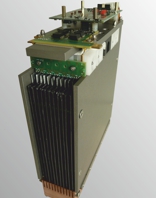Fraunhofer ISIT presents extremely robust high-power energy storage for electromobility
During most of the operating time road vehicles run in the partial-load operational range. For short term "power-hungry" activities such as overtaking, pulling out into traffic on the highway etc. significant additional power reserves must be held available. For these power peaks Fraunhofer ISIT has developed an additional modular accumulator system in the last two years, consisting of an extremely robust high-power battery ("Li-Booster") combined with a highly responsive and power efficient battery electronics. At this year's International Motor Show in Frankfurt, Fraunhofer ISIT will present this lithium-booster-system the public.
The reduction in engine displacement of internal combustion engines in order to reduce fuel consumption while maintaining the performance (downsizing), requires an ever greater effort, yet is subject to physical limitations. In addition, because of regularly occurring periods of high load, the installation of actually oversized motors is necessary. "Our new high-power batteries only come into use when momentary power peaks occur and thus allow the use of smaller and more efficient combustion engines," Dr. Andreas Würsig, head of Integrated Energy System at ISIT, explains the motivation for the development of the new system.explains
The research for the development of the booster focused mainly on two priorities. The first was the development and construction of high-power battery cells. The aim was to select appropriate materials and develop manufacturing processes that ensure a long service life and safety, while providing the potential for a very good lad capability. Electrochemical energy storage devices with lithium titanate as the anode material and lithium manganese oxide as the cathode material comply with these requirements. For the lithium-booster also a separator, developed by ISIT, was used. The result was a 3.3 Ah battery cell that can be discharged with 165 A over a short period of time.
In the lithium-booster every 12 high-power cells are connected to form a battery module. The whole system is set up depending on the application of a variable number of these modules.
The second focus of development was the battery electronics. Researchers at ISIT developed a specific approach to battery management. It naturally offers the usual features of such a system, as a very accurate measurement of cell voltages, has a short circuit and overload protection and monitors the cell temperature.
In addition, the electronics ensures that the charge states of the individual cells do not gradually drift apart during operation. Within the individual modules it distributes the excess energy of a single cell to another.
For the balance between the modules, the researchers at ISIT have devised a new effective method of power distribution: Instead of to moving energy between the modules, the electronics bridges complete modules, if necessary. This method brings several advantages: Different states of charge of the individual modules are balanced very fast and with low-loss. In addition, the high-voltage battery is fully de-energized with electronics switched off. This reduces the potential hazard during servicing and in particular in case of accidents.
Based on the cells developed by ISIT and the electronics, the developers, together with their colleagues at the Fraunhofer IIS, have constructed the complete battery, including a cooling system, as prototype. The researchers involved in the project believe that the Lithium-Booster will achieve market readiness within the next two years. Its potential additional fields of application thereby full electric vehicles, hybrid vehicles with fuel cells, start / stop systems, starter batteries and accumulators for the future 48 V vehicle electrical system.
The prototype was developed as part of the "Fraunhofer Systemforschung Elektromobilität", a joint project in which 16 different Fraunhofer institutes are pooling their expertise. Funded by Fraunhofer-Gesellschaft, the research focuses on a clearly defined range of applications for electromobility. Project activities are grouped in three clusters: “Drivetrain / Chassis”, “Battery / Range Extender”, and “Body / Infrastructure”. With the development of innovative technologies and components for hybrid and electric vehicles, the partners aim to create attractive offers for the automotive industry.
 Fraunhofer Institute for Silicon Technology
Fraunhofer Institute for Silicon Technology